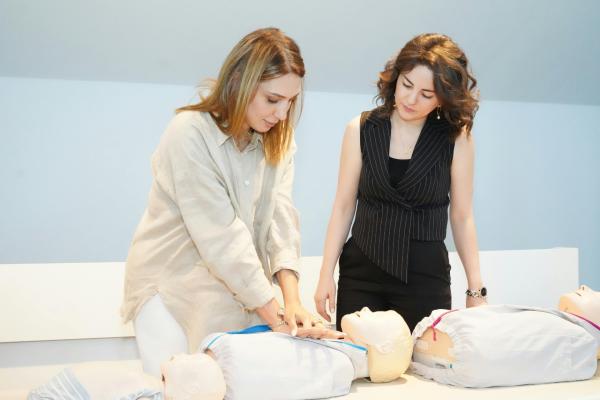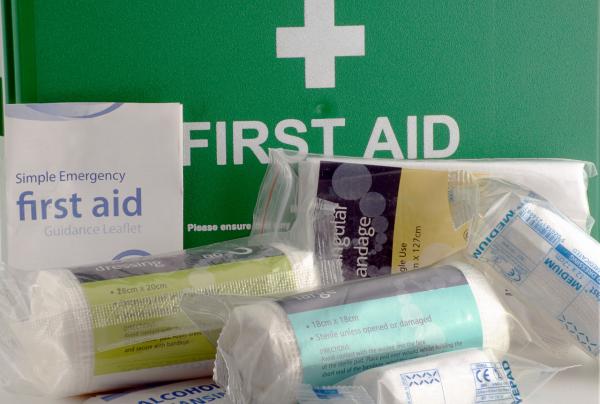When a medical emergency strikes, the first few minutes are often the most critical. Whether it's a colleague collapsing at work, a customer experiencing breathing difficulties, or someone suffering a severe injury, the ability to provide immediate and effective assistance can determine the outcome. Emergency first aid training equips individuals with the essential skills needed to respond confidently and competently during those crucial first moments before professional medical help arrives.
In today's fast-paced work environments, accidents and medical emergencies can happen at any time. From office buildings to construction sites, retail spaces to educational institutions, no workplace is entirely immune to sudden medical crises. Whilst we hope such situations remain rare, being unprepared when they do occur can have devastating consequences. Emergency first aid training bridges the gap between the moment an emergency occurs and the arrival of paramedics, providing essential interventions that can preserve life, prevent conditions from worsening, and promote recovery.
Table of Contents
- What Is Emergency First Aid?
- Core Skills in Emergency First Aid Training
- The Importance of Emergency First Aid in the Workplace
- Course Overview
- Who Should Undertake Emergency First Aid Training?
- Refreshing and Maintaining Emergency First Aid Skills
- Booking Emergency First Aid Training with SafeHands
- Conclusion
1. What Is Emergency First Aid?
Emergency First Aid Training (also known as Basic First Aid training) refers to the immediate care provided to someone experiencing a sudden illness or injury, particularly when that condition poses an immediate threat to life. The focus is on rapid assessment and swift intervention for critical situations rather than treatment of minor injuries or ongoing medical conditions.
Emergency first aid training concentrates on high-priority, life-threatening scenarios: someone who has stopped breathing, whose heart has stopped beating, who is unconscious, choking, bleeding severely, or in shock. These are situations where minutes – or even seconds – matter, and where the actions of a trained individual can make the difference between life and death.
Training typically covers essential skills including cardiopulmonary resuscitation (CPR), use of automated external defibrillators (AEDs), management of choking in adults and children, control of severe bleeding, treatment of shock, and management of unconscious casualties. Participants learn to conduct primary surveys, assess vital signs, and prioritise care when multiple casualties are involved.
One of the fundamental principles taught in emergency first aid is the concept of the "chain of survival" – the sequence of actions that gives a casualty the best chance of survival. Emergency first aiders play a crucial role in the initial links of this chain, and research consistently shows that early intervention by trained laypersons significantly improves survival rates.
2. Core Skills in Emergency First Aid Training
Emergency First Aid Training equips participants with a focused set of life-saving skills, each designed to address immediate threats to life. These core competencies form the foundation of effective emergency response and can mean the difference between life and death when minutes matter most.
Cardiopulmonary resuscitation remains one of the most vital skills taught in emergency first aid courses. When someone's heart stops beating effectively, their brain begins to suffer damage within minutes due to lack of oxygen. CPR manually pumps blood around the body, maintaining a minimal circulation that keeps vital organs supplied with oxygen until the heart can be restarted. Modern CPR training emphasises high-quality chest compressions at the correct rate and depth.
The introduction of automated external defibrillators has revolutionised emergency cardiac care. These remarkable devices analyse a casualty's heart rhythm and, if appropriate, deliver an electrical shock to restart the heart. Modern AEDs are designed to be used by laypersons with minimal training, providing clear voice instructions throughout the process. Time to defibrillation is one of the most critical factors in surviving cardiac arrest.
Choking represents another life-threatening emergency requiring immediate intervention. When an object completely blocks someone's airway, they may have only minutes before they lose consciousness and suffer cardiac arrest. Emergency first aiders learn to recognise the signs of complete airway obstruction and to perform back blows and abdominal thrusts to dislodge the obstruction.
Severe bleeding can rapidly lead to life-threatening shock if not controlled promptly. Training teaches participants to assess the severity of bleeding and apply appropriate techniques to control it, including direct pressure, elevation, and the use of pressure points when necessary.
Managing an unconscious casualty requires specific knowledge to ensure their airway remains open and they continue breathing. Training teaches the recovery position, a stable position that keeps an unconscious but breathing person on their side, allowing fluids to drain from their mouth and preventing the tongue from blocking the airway.

3. The Importance of Emergency First Aid in the Workplace
Workplaces have both legal and moral responsibilities to ensure the health and safety of their employees. Having trained first aiders is a key component of this duty, and for many organisations, emergency first aid training represents the minimum acceptable level of first aid provision.
Current legislation in Ireland requires employers to make appropriate first aid provision for their workforce, with the level of provision depending on various factors including the nature of the work, the number of employees, and the specific hazards present. For many workplaces, having employees trained in emergency first aid represents the minimum acceptable level of first aid provision.
The immediate availability of trained first aiders can significantly impact outcomes when workplace emergencies occur. In industries with higher risk profiles, the potential for serious injuries is greater, making rapid emergency response even more critical. However, medical emergencies don't discriminate by industry; a heart attack can strike an office worker just as easily as a factory employee.
Beyond the practical benefits of emergency response capability, having trained first aiders contributes to a positive safety culture within an organisation. It demonstrates to employees that their wellbeing is valued and that the organisation takes its safety responsibilities seriously. This can improve morale, increase trust, and even serve as a recruitment and retention tool.
The psychological benefits should not be underestimated. Witnessing a medical emergency can be traumatic, particularly if bystanders feel helpless. Training provides people with the knowledge and skills to take positive action, which can reduce feelings of helplessness and anxiety.
4. Course Overview
SafeHands Health & Safety Solutions provides comprehensive emergency first aid training in Ireland (also known as Emergency First Aid at Work) suitable for workplaces of all types and sizes.
Course Duration: Approximately 5 hours
Maximum Participants: Up to 10 participants per session to ensure everyone receives adequate hands-on practice and individual feedback
Certification: Participants receive a recognised Emergency First Aid at Work certificate valid for two years upon successful completion. Refresher training is recommended annually to maintain competency.
The course focuses on life-saving interventions and immediate emergency response, covering CPR, AED use, choking management, severe bleeding control, and management of unconscious casualties. Practical skills training forms the majority of the course, ensuring participants gain confidence through repeated practice.
5. Who Should Undertake Emergency First Aid Training?
Emergency first aid training is valuable for virtually anyone, but certain groups have particular reasons to prioritise this training. Understanding who benefits most helps organisations allocate their training resources effectively.
Designated workplace first aiders are the most obvious category – individuals specifically appointed by their employers to take responsibility for first aid provision within the organisation. These appointees require formal certification through recognised training courses and must keep their qualifications current through regular refresher training.
Supervisors and managers benefit significantly from emergency first aid training, even if they're not designated as workplace first aiders. These individuals often have responsibility for others and may be the first point of contact when emergencies occur. Being able to provide immediate assistance whilst arranging for additional help can be crucial.
Employees working in isolated or remote locations have particular need for emergency first aid skills. When professional medical help is far away or may take considerable time to arrive, the ability to provide effective emergency care becomes even more critical.
Customer-facing staff in retail, hospitality, and service industries should consider emergency first aid training, as they may need to respond to emergencies involving customers or members of the public. The ability to respond confidently to a customer emergency reflects well on the organisation and can save lives.
Teachers, teaching assistants, and other education professionals have obvious reasons to maintain emergency first aid skills, given their responsibility for the safety of children and young people.

6. Refreshing and Maintaining Emergency First Aid Skills
Emergency first aid skills, like any practical competency, require regular practice and updating to remain effective. The combination of evolving medical guidelines and the natural degradation of skills that aren't used regularly makes refresher training essential.
Most emergency first aid certifications are valid for three years, but many organisations and experts recommend annual refresher training to ensure skills remain sharp. The rationale is straightforward: most people will hopefully never need to use their skills in a real situation, but years may pass between training and any practical application. Under the stress of a genuine emergency, skills that haven't been practised can be difficult to recall and execute effectively.
Refresher training typically focuses on practical skills rather than theoretical knowledge, allowing participants to practise the physical procedures involved in CPR, defibrillator use, choking management, and bleeding control. These sessions often incorporate scenario-based training, where participants work through realistic emergency situations.
Between formal training sessions, there are several ways individuals can maintain their readiness. Many training organisations provide access to online resources, including videos demonstrating techniques and quick reference guides. Some organisations conduct brief informal practice sessions during team meetings, allowing staff to refresh their memory of key procedures.
7. Booking Emergency First Aid Training with SafeHands
SafeHands provides comprehensive emergency first aid training across Ireland designed to equip participants with the skills and confidence needed to respond effectively to life-threatening emergencies. Training is delivered by qualified instructors whose credentials are available on request, ensuring participants receive high-quality instruction based on current best practices.
All training is conducted at a venue provided by the client or on-site at the client's premises. This approach offers significant advantages, allowing participants to train in familiar surroundings and enabling instructors to contextualise the training to the specific environment where participants may need to use their skills. On-site training also eliminates travel time and expenses for participants.
To arrange emergency first aid training, organisations or individuals can submit an enquiry through the SafeHands website. The scheduling of training depends on trainer availability and can be arranged to suit the needs of the client. This flexibility allows training to be scheduled at times that minimise disruption to normal operations.
Payment for training courses is straightforward and required upfront. SafeHands accepts payment through several methods including Stripe, bank transfer, and telephone payment. For organisations choosing to pay by bank transfer, an invoice will be emailed containing the necessary bank details. The full course fee is payable when booking, with no deposit options or payment plans available.
Emergency first aid training represents an invaluable investment in safety, preparedness, and peace of mind. The skills learned in these courses are genuinely life-saving, and having trained individuals within an organisation provides a critical capability that can make all the difference when emergencies strike.
8. Conclusion
Emergency first aid skills are among the most valuable capabilities any individual can possess. In those critical moments when someone's life hangs in the balance, the knowledge and confidence to take immediate, effective action can determine whether they survive and recover or suffer permanent harm. Emergency first aid training transforms bystanders into capable responders, providing the skills needed to maintain life until professional medical help arrives.
For organisations, having trained first aiders isn't just about meeting legal requirements – it's about creating a culture of safety and demonstrating genuine care for employees, customers, and anyone else who might be affected by a medical emergency. The investment in training pays dividends not only in terms of emergency preparedness but also in employee confidence, morale, and organisational reputation.
Whether you're an employer looking to meet your obligations for first aid provision, a manager wanting to enhance your capability to protect your team, or an individual who simply wants the confidence of knowing you could help in an emergency, emergency first aid training is an essential step. Contact SafeHands today to arrange training that will equip you with the skills to respond effectively when every second counts.

